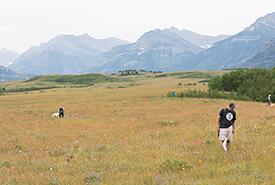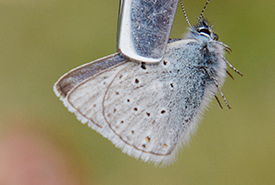Encountering Waterton

Butterfly count at the Waterton Springs campground (Photo by NCC)
During my travels, I’ve seen a variety of mountains: the ancient remains of volcanic peaks in Tasmania, the coastal slopes of the Sierra Nevada range in southern Spain, the aptly-named Remarkables of New Zealand. I know that not all mountains look alike, so I don’t know why I expected Waterton to look a lot like my hometown of Canmore.
I rolled into Waterton for the first time in a van stuffed with Nature Conservancy of Canada (NCC) staff, volunteers and so much gear that the space between the seats was crammed with backpacks and butterfly nets. We were headed there for two days of Conservation Volunteers events to remove invasive species and count butterflies (hence the abundance of butterfly nets occupying our leg space).
The drive from Calgary south to Clairsholm was as flat and dull as you’d imagine, and despite knowing that the Rocky Mountains flanked our journey on the western horizon, dark ominous rainclouds hid their stony peaks from view and silently threatened to dampen our planned two days of outdoor activities. When we peeled off of Highway 2 and turned towards Pincher Creek, the rain that had been threatening in our peripheries started pouring down.
But somewhere between Pincher Creek and the Waterton National Park, the weather broke. The rain began to abate, then vanished completely. By the time we rounded Pine Ridge, the clouds were beginning to break, giving me my first view of the Waterton Park Front.
I’ve seen a lot of mountains, and spent a great deal of my life exploring them. I’d never seen anything like Waterton before. In school we learned how mountains are formed. The Earth’s fault lines grind together, lifting one plate and thrusting the land upwards to create mountains, which give way to foothills before dissipating into the rolling prairie. Except apparently this is not always the case, because in Waterton the golden prairies end abruptly, interrupted by the upwards thrust of steep mountain peaks, breathtaking in a way neither words nor images can portray.

Butterfly encountered at the Waterton Springs campground (Photo by NCC)
Volunteers get to work
I spent the better part of two days luxuriating in the scenic views and fresh mountain air. The purpose of my trip was not a vacation however, but work. I was sent down to Waterton to document and record the two Conservation Volunteers events with my camera, pen and paper. On Monday, July 21 we hosted a weed pulling event at the Hayden-Hedenstrom property, and the next afternoon there was a butterfly count, split between the Waterton Springs campground and the Bruder property.
The first day, approximately a dozen volunteers came out for an event that had been rescheduled once already due to heavy rainfall. Despite our earlier misgivings, the weather turned hot and sunny. Armed with a keen group of volunteers, we removed 11 large black garbage bags full of weeds from the one-kilometre road leading into the property.
The Road to Recovery IV is one example of many long-term efforts NCC puts into the conservation of their property. This bi-annual event began eight years ago, and some of the volunteers who had participated at the first event almost a decade ago can attest to the positive impact NCC has had on the land. Although there was no shortage of weeds left to pull, volunteers were wandering farther into the forest to find plants that had escaped from a roadway that had taken years to clear.
Chasing butterflies
The following day’s butterfly count was an event I’d been looking forward to for weeks. As an aspiring photojournalist who has spent the entire summer packing my camera across the province, I knew this was an event that was guaranteed to be a photographic goldmine. In my mind I had already composed a dozen images of children with nets, chasing butterflies through a sunny field of wildflowers. This is a reflection of my inexperience as a photographer; I have yet to learn that you never set expectations for a shoot.
On Tuesday morning, the clouds from the day before returned and refused to clear. The rain held off until the end of the event, but much like us, butterflies enjoy sunshine, and the cloudy skies drove the bigger, brighter species into hiding. At first glance, the campground seemed barren of our fluttering friends. Fortunately this was not the case, and closer inspection revealed a society of smaller species in the tall native grasses.
Some of my favourite photographs from the day were not the ones I’d envisioned; they aren’t small children in sundresses waving nets overhead. Instead, one image is an older man with white hair and sunglasses. He is alone in the shot, walking through a field scattered with wildflowers, wielding a butterfly net one-handed. On his face is a look of concentration. Another shot is a student in his mid-twenties, smiling through a bushy brown beard. His hand is outstretched, and in the middle of his palm is a small brown butterfly.
So many favourite moments
We drove back to Calgary on Tuesday after the event. It was a quiet car ride home, though whether it was because our crew was asleep or silent in contemplation is up for debate. We arrived in the city later than intended, watching the light fade in the sky as the cityscape grew larger on the horizon. Before we reached our intended destination I pulled out my voice recorder and asked each of the passengers in the van, “What was your favourite part of the trip?”
So what was my favourite part? It’s difficult to pinpoint one moment in particular, but if I had to choose, I would say that it was exploring the area after dinner on Monday evening. Cruising down the highway, we saw a sign for a buffalo paddock in the park front and decided to stop in and visit it. The area was quiet so we were able to park the van along the roadside and admire the view: a herd of buffalo grazing on golden prairie grass against the backdrop of the magnificent Canadian Rockies.
It’s moments like those that really allow me to appreciate the work we do in fantastic places across the country. Although most of my job is based out of an office in Calgary, it’s important to get away from time to time and to visit these areas; to witness the natural beauty and understand how special they are. Maintaining these landscapes is important to me, and this is why I work at the Nature Conservancy of Canada.


